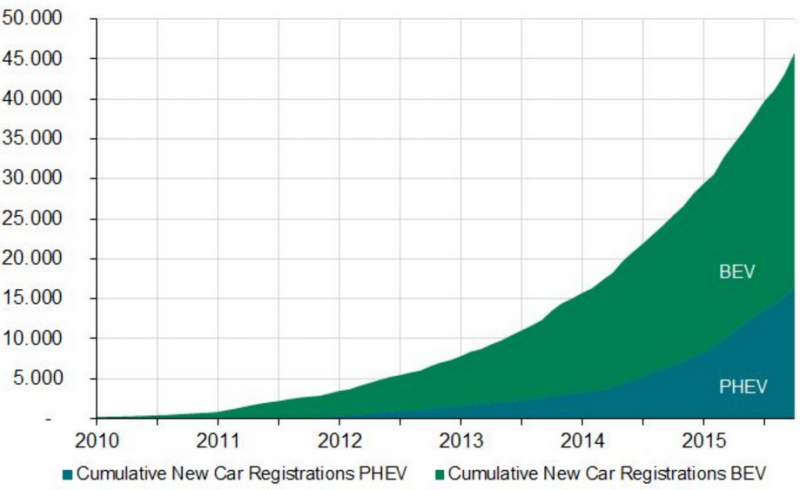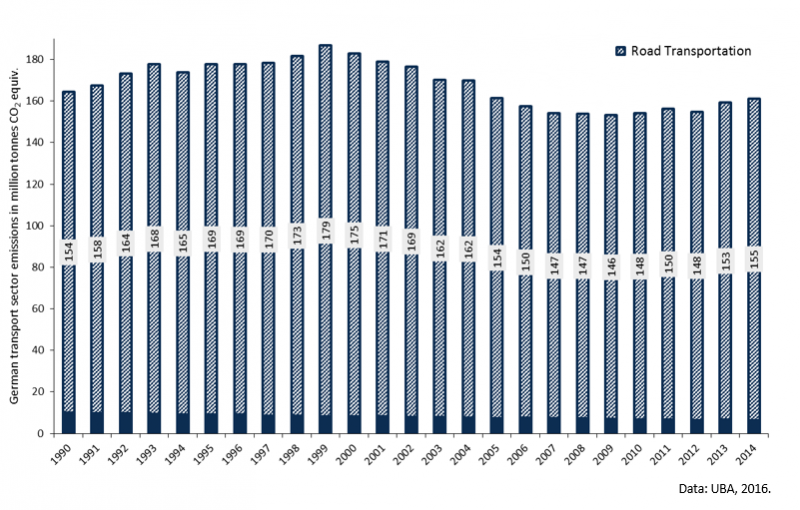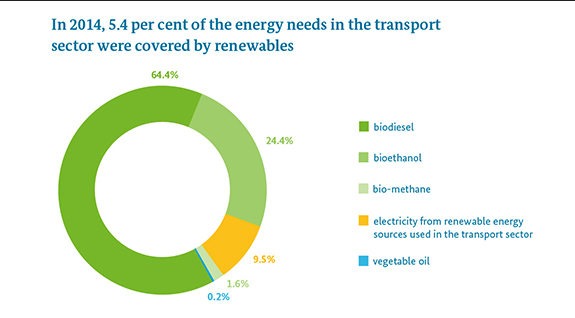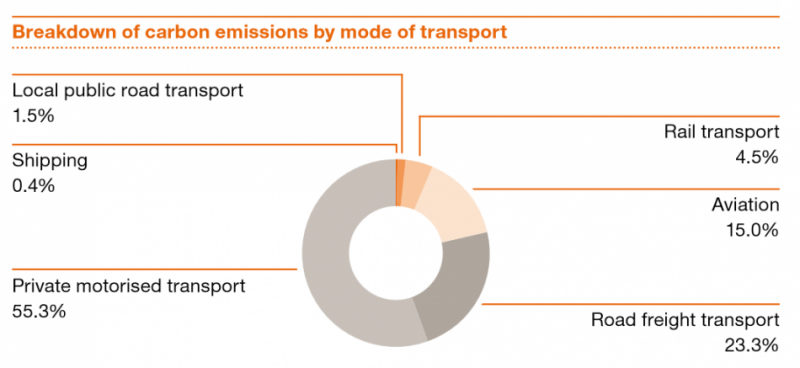Car giant Germany struggles to ignite Energiewende in transportation
Content
Transport emissions unchanged since 2007
Policy ideas abound, but progress remains slow
Outdated Strategies
Are carmakers a boon or bane for the transition?
German carmakers “finally get serious” about e-cars
Efficiency and Emissions Standards
Germany fought stricter EU emissions rules
Will e-cars or emission limits have the biggest impact?
In sustainable mobility, the Germans aren’t out in front, not by a long shot. Take, for example, the number of electric vehicles: At the start of 2016, there were only 25,502 pure electric cars registered in Germany - around four times as many purr along California's roads alone.
No wonder Germany currently looks incapable of fulfilling its official target of putting a million electric vehicles (EVs) on the road by 2020, which experts say is crucial to reaching the country’s 2020 target of reducing carbon dioxide (CO2) emissions by 40 percent compared to 1990 levels.
Greening Germany’s transport sector will be a massive undertaking, and it will basically have to start from scratch. A PricewaterhouseCoopers study notes that the energy transition has barely affected transport emissions yet and concludes that “the transport-related climate targets cannot be met unless the transport sector is transformed radically.”
Mobility expert Peter Kasten from the Institute for Applied Ecology sees difficult choices ahead for consumers, politicians, and the carmakers. “Transportation hasn’t been a priority in the Energiewende, not yet,” he told the Clean Energy Wire. “Decarbonisation isn’t happening anywhere in the sector. Measures are expensive and intervene with our daily life. Thus, it just hasn’t been pushed by either politicians or industry.”
Transport emissions unchanged since 2007
On paper, the decarbonisation of the transport sector is a central pillar of Germany’s Energiewende - on a par with green power generation, energy efficiency, or the nuclear phase-out. It implies far more than just getting e-cars on the road, and includes entirely new mobility concepts, low-carbon shipping and aviation, as well as climate-neutral public transport.
But looking beyond cars, the picture is even less promising: The transport of goods on Germany's roads with diesel-powered trucks is on the rise, while rail freight is decreasing, even though environmentalists and German government officials agree the opposite is necessary. In air travel, primary energy consumption is also on the rise.
Emissions statistics illustrate the crucial role of transport for decarbonising the economy. The sector accounted for about 28 percent of Germany’s total final energy consumption in 2014, and 164 million tonnes of CO2 emissions - 20.5 percent of the country’s total.
The sector’s carbon emissions have remained largely constant since 2007; 94 percent of Germany’s transportation fuels comes from fossil energy sources, and less than six percent from renewables.
The major culprit among the modes of transportation is passenger cars. Cars account for more than half of Germany’s transportation sector’s total emissions, followed by road freight (commercial trucks), which emits just under a quarter of the sector’s CO2, and then aviation (15 percent).
“The long-term greenhouse gas reduction goals require a low-to-zero-carbon transport sector,” says Kasten. “German carmakers have to adapt their profitable businesses and, in contrast to the electricity sector, it means that people have to change their habits.”
Policy ideas abound, but progress remains slow
The Energy Concept, the government’s road map for the renewables transition, and subsequent measures, such as the 2014 National Action Plan on Energy Efficiency (NAPE), outline the promotion of a broad range of renewables technologies and policy instruments including the promotion of EVs, hydrogen and fuel-cell technology, low-carbon conventional transportation, biofuels (for use in air travel, too), an emissions-based vehicle tax, special freight corridors, and an expanded railway network. The Energy Concept’s goals for transportation have been expanded since 2010 (see Factsheet Vague goals, modest strides), yet they remain mostly vague and unfulfilled – a work very much in progress.
A November 2015 report by the International Renewable Energy Agency (IRENA) chastised Germany for not doing more with renewable transportation technologies. “Germany’s rapid renewable energy expansion and ambitious targets have demonstrated to the world that a 30 percent share of renewable power is possible,” said IRENA Director-General Adnan Z. Amin. “However, to meet even higher shares and continue building one of the world’s most energy-efficient, sustainable and low-carbon energy systems, Germany must now expand its focus beyond the power sector,” said Amin, explicitly mentioning Germany’s heating and transportation sectors.
These are sobering indictments given transport is so central to making the Energiewende a success. So what’s wrong? Why doesn’t Germany lead the pack?
Outdated Strategies
For one, Germany’s policy framework is now “definitely out-dated,” says Kasten. Studies underlying the Energy Concept relied heavily on biofuels for decarbonising transportation, for example. But it has become clear that “there’s not nearly enough of it,” requiring new discussions about goals and strategies, according to Kasten.
Where that discussion will lead is uncertain, although electromobility is more in vogue now and biofuels less so than five years ago. Importantly, Germany’s ongoing quest to green the diverse sector remains “technology neutral,” in other words it is still wide open to different technological options or combinations of technologies. Even though the government and the greater Energiewende community have strongly promoted e-mobility in recent years, it is by no means clear whether Germany’s highways in 2030 will be full of EVs, hybrids, hydrogen cars, biofuel or synthetic-fuel-powered vehicles, pedelecs, bicycles or something else entirely – or some mixture of all of them.
“It’s right not to exclude options,” says Felix Horch who works on e-mobility at the Fraunhofer Institute for Manufacturing Technology and Advanced Materials (IFAM) in Bremen and notes that Germany has already excluded nuclear power. “Your average person is going to have needs different from industry’s, and there will be diverse requirements in industry, too, which may be different from those of public transportation. We don’t know what the final mix is going to look like.”
Are carmakers a boon or bane for the transition?
It is certain, however, that automobiles – passenger cars, trucks, sports and off-road vehicles, and buses – will be at the centre of the agenda. Germany’s carmaking prowess makes the transition in this sector all the more complicated – but also potentially lucrative, as one in every five cars worldwide is a German brand.
Yet in 2015, there were just 12,363 e-cars among the 3.2 million new cars registered in Germany that year – a share of 0.4 percent. In terms of total number of electric vehicles on the road, Norway, with a population of five million as opposed to Germany’s 81 million, has almost twice as many e-cars on the road as Germany. Compare these numbers with Germany’s pioneering role when it comes to e-bikes, with more than two million on the road.
The powerful German automobile industry trails its peers in Asia and North America although it now finally offers an array of passenger EVs from BMW’s flashy i3 to Volkswagen’s e-Golf.
In fact, say most experts, it’s largely because of Germany’s esteemed automobile industry that progress has been so slow. “The blame lies with the German carmakers and their very powerful lobby groups,” says Weert Canzler of the Innovation Center for Mobility and Social Change (InnoZ), a Berlin-based institute and on-site pilot project.
“The industry earns its money with big gas-guzzling cars,” says Canzler. He argues most German car companies only started to build electric cars when demand and higher emissions standards left them no other option. “With the single exception of BMW, they’ve been forced to go electric. They didn’t do it of their own accord.” The revelation that Volkswagen diesels cheated to pass ever more rigorous emissions standards, he says, means that “we’re seeing the day of the combustion engine come to an end. They’re able to meet stronger CO2 limits only with extremely high effort and cost.”
In response to such fierce criticism, the German auto industry fires back. The German Association of the Automobile Industry (VDA) points out that German carmakers invest billions of euros a year in R&D, much of which goes toward green technology, such as alternative mobility and advances in fuel efficiency. In 2014 alone, Germany’s automotive industry R&D expenditure topped 17.6 billion euros, one third of Germany’s total R&D expenditure, and R&D personnel within industry tallied just over 93,000 in 2014, according to Germany Trade & Invest, Germany’s economic development agency. The German government added 1.5 billion euros to the carmakers’ research endeavors.
In terms of electromobility, Germany “is at the top,” says VDA spokeswoman Sandra Courant. There were 29 German-made EVs on the market at the start of 2016 – no other country could boast a similar model range, according to VDA. Daimler’s Smart Fortwo Electric Drive, Audi’s A3 e-tron, the BMW i3 and the e-Golf all sold better in 2014 and 2015 than did any German model before them.
Moreover, since 2008 the average level of carbon emitted by new German cars has sunk by 17 percent – but this figure was calculated before the 2015 VW scandal underlined that such figures might not be reliable, as they were obtained in the laboratory, rather than on the road.
Nevertheless, Germany’s streets are not lined with EVs. Germany’s slowness to embrace sustainable mobility, however, isn’t that different from most other countries’ failure to usher in a new age of alternative, low-carbon transportation – whether they’re world-renowned motor-vehicle aficionados or not. Well-off Norway and its best-practice city of Oslo – which intends to be free of conventional automobiles by 2019 – are exceptions largely because of the generous subsidies and rebates that the government offers, as well as the fact that Norway’s power is almost exclusively green thanks to its enormous hydroelectric capabilities. Worldwide, the transportation sector accounts for approximately 23 percent of total energy-related CO2 emissions (based on 2010 figures).
German carmakers “finally get serious” about e-cars
Even if hydrogen, biofuels or synthetic fuels (see Factsheet on the future of transport fuels) contribute more rather than less to the decarbonisation of transportation, the emergence of ever-more viable plug-in, battery-powered varieties of electromobility has shed new light on the shape that the transition will take. The all-electric plug-ins – in particular their batteries – have become much cheaper, better performing, and physically more compact in the course of the last decade.
“The American carmaker Tesla made the breakthrough,” explains Ferdinand Dudenhöffer, who holds a chair in business studies focusing on the automobile industry at the University of Duisburg-Essen. “Now just about the entire [automobile] industry, Germany’s included, is moving in the direction of all-electric EVs.”
Tesla’s models, he says, with ranges of up to 500 kilometres and quick-charging batteries shifted the EV market’s parameters. “The Germans were mucking around with gimmicks like plug-in hybrids which make no sense at all,” he says, referring to their high cost, the weight of two motors, and the low ranges of their batteries. “Now all of the German carmakers and some suppliers, too, such as Bosch, are finally getting serious about putting viable all-electrics on the market,” he says. “This is the solution for tomorrow.”
Advocates of e-mobility say that Germany would have more e-cars on autobahns if they were more affordable. EVs sell at about twice the price of their diesel or gasoline-fueled peers, as is the case with VW’s Golf and the e-Golf. The highly touted BMW i3 goes for 45,740 euros.
Yet, Germany does less to incentivise EV sales than other countries. The perks for German buyers of EVs include exemption from an annual circulation tax for ten years and, as of 2015, some special parking and roadway privileges, like driving in bus lanes and noise-reduced areas. Michael Müller-Görnert from green transport association VCD says that for a medium-sized gasoline automobile the circulation tax would be about 25 euros a year and for a diesel around 180 euros a year. "This is really very little. It's not much of an inducement at all." The German government has said it wants to push e-cars with new incentives, but details have yet to be settled.
In contrast, France, Ireland and the UK offer rebates of up to 6,300 euros and tax breaks, too. Norway offers tax cuts and benefits including an exemption from tolls and parking fees, free recharging stations, and the use of bus lanes. California, which dangles rebates of 2,500 dollars for EVs, requires car manufacturers to produce a certain percentage of zero-emission vehicles. By 2025, 15 percent of all cars and vans sold in California must be powered either by electricity or fuel-cells.
Dudenhöffer and other critics of Germany’s pace in introducing electromobility say that it should be one of the countries to gain most from e-mobility’s climate mitigation potential. “We have the green electricity from the Energiewende,” he says. “This makes our EVs completely free of CO2 emissions and other greenhouse gases.”
Germany’s Energiewende is also responsible for driving the expansion of the country’s intelligent power grid infrastructure, which will become more integrated and smarter in the years ahead. This has German experts looking into ways to link e-mobility, clean energy and urban infrastructure through decentralised power grids. Both carmakers Daimler and BMW already explore the potential of used e-car batteries for large scale grid storage in pilot projects. These could lower the costs of producing new e-cars further.
A solution to the transportation conundrum may lie in combining different modes of travel to optimise climate protection efforts. This means using multiple modes of mobility in a single trip, such as sharing an e-car to drive to a train station, taking the train to the city center, and then using a bicycle to get to the work place. In order for this to work, cities have to be designed to make it possible and attractive.
"Combined transport is an important component of a climate-friendly transport system,” says Rita Schwarzelühr-Sutter, Parliamentary State Secretary at the environment ministry, which promotes the expansion of combined freight transport with 130 million euros a year. “The advantages are obvious,” she says, “it offers a flexible solution for the transport of goods, bundles traffic, reduces emissions, and saves money."
Pilot projects are already in place. Berlin’s InnoZ institute, for example, is at the cutting edge of a holistic approach to mobility and intelligent cities. InnoZ works together with corporate actors and ordinary burghers to test new ways to integrate e-mobility into low-carbon cities. It has 40 EVs – all charged at least partly from wind and solar power – that function both as storage units (through their batteries) and as a fleet that users can share from. “The technology’s already there. It’s more of a management challenge,” says Weert Canzler.
Efficiency and Emissions Standards
Like all of its EU peers, Germany has committed itself to raising efficiency and emissions standards, in particular for cars and vans. The EU has set mandatory average emissions limits for the fleet of cars manufacturers sell each year. The aim is to improve fuel economy and lower emissions. As of 2015, new passenger cars may emit no more than a fleet average of 130 grams of CO2 per km. For fuel consumption, automobiles must use less than 5.6 litres of gasoline per 100 km or 4.9 litres of diesel per 100 km on average. By 2021, the annual fleet average for new cars cannot exceed 95 grams of CO2 per km, to be phased in as of 2020. According to the EU’s climate protection office, the 2015 and 2021 targets “represent reductions of 18 percent and 40 percent, respectively, compared with the 2007 fleet average of 158.7g/km.”
Although this may look ambitious, there are already more than 850 models on the German market with emissions levels of 130 grams per km and 500 models that keep emissions below 120 grams of CO2 per km.
Germany fought stricter EU emissions rules
Indeed, the EU had still stricter targets in mind in 2013. But Germany lobbied fiercely to have them watered down. Chancellor Angela Merkel headed up a rebellion of automobile-manufacturing nations against more stringent emissions standards for vehicles. Germany leaned heavily on the environmentally minded member states and even, according to The Guardian, pushed the EU to keep loopholes in testing. Berlin’s efforts to overturn the draft regulations began immediately after the reelection of Merkel’s party in 2009. At the same time, just weeks after the vote, critics cried foul when it turned out that Christian Democrats had received donations totaling 690,000 euros from the family that largely controls BMW.
The German Association of the Automotive Industry VDA takes issue with too critical an assessment of the German auto industry, which it told Clean Energy Wire has lowered fuel consumption and CO2 emissions limits for new vehicles by a quarter in the last ten years. Citing figures from the Federal Environment Agency, the VDA says Germany is the only Western European country that has reduced CO2 emissions of all road traffic to below the 1990 level.
More recently, with the assistance of the European Automobile Manufacturers Association –Germany muscled through measures at the EU level to delay a more rigorous “real driving emissions” test for nitrogen oxides for diesel cars and higher emissions standards for the greenhouse gas. Although the on-the-road testing would make Europe the first to take such testing out of the laboratory, this second postponement of higher standards allows European cars to emit twice the current limit of the toxic gases from 2019 and up to 50 percent more from 2021. Nitrogen oxides were at the center of the Volkswagen scandal this autumn. Germany and three other EU nations are currently facing EU action against their higher-than-allowed nitrogen oxide levels.
Will e-cars or emission limits have the biggest impact?
Many proponents of electric and other forms of alternative mobility say that more rigorous EU and national emissions criteria for conventional cars are the key to making transport more eco-friendly, and more important than hurrying e-cars onto the road. They argue that more efficient, fossil-fuel-burning vehicles, which emit ever-lower emissions, are the best bet until the power supply is greener. More than 40 percent of Germany's power is still produced using coal.
“E-cars aren’t the option we need right now,” says Axel Friedrich, an independent transportation expert and member of the International Council on Clean Transportation (ICCT). Friedrich and other experts argue that as long as electrics charge from a grid that is still as conventional as Germany’s (a kWh of electricity produces around 600 grams of CO2) then low-emission conventional cars make more sense than e-cars.
“The government’s main error is that it prioritises precisely those kinds of electric mobility that will only be able to reduce CO2 emissions in the distant future," says Friedrich. The way forward, he argues, is for states to set high standards for ever lower CO2 emissions and let the auto industry meet those standards with whatever technology it chooses.
Friedrich argues that Germany is de facto no longer technology neutral, which he calls a serious mistake. The incentives for developing EVs are “simply money in the pockets of the perpetrators – and the result is higher CO2 emissions in Germany and elsewhere,” says Friedrich.
Oliver Lah of the Wuppertal Institute for Climate, Environment and Energy is also convinced that e-mobility is being pushed onto the road too soon. “We need low-carbon transport alternatives in our cities like public transport, walking and cycling,” he says.
While Lah argues that developing selected e-mobility solutions makes sense in the long-run, today Germany should harness the efficiency potential of existing vehicle technologies and steer consumer behaviour towards more efficient vehicles and other modes of travel. “E-mobility can then help Germany and other countries achieve long-term climate targets,” he says. But the intermediate priorities, he maintains, are: urban planning, low-carbon transportation and fuel efficiency.
Germany’s mobility transition – on anything near the scale of the transition to clean power – is still a distant prospect. There’s no consensus on how it should be done – neither in the automobile industry, government circles, nor among the expert community committed to the Energiewende. Nevertheless, argues Weert Canzler, Germany can catch up. With “its tech know-how, smart grid start-ups, and the established automobile industry, Germany is in a good position to make the transition to post-fossil mobility,” he says.
Paul Hockenos is a freelance contributor to the Clean Energy Wire. He has also written about energy issues for a wide range of international publications and is the author of the blog Going Renewable. He is the author of Joschka Fischer and the Making of the Berlin Republic: An Alternative History of Postwar Germany (Oxford University Press).




